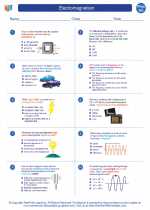Molecules: Explanation and Study Guide
Explanation
A molecule is a group of two or more atoms that are chemically bonded together. This bonding can occur through various types of interactions, such as covalent bonds, ionic bonds, metallic bonds, or hydrogen bonds. Molecules can be composed of atoms of the same element or different elements.
For example, a molecule of water (H2O) consists of two hydrogen atoms and one oxygen atom bonded together through covalent bonds. Another example is a molecule of carbon dioxide (CO2), which consists of one carbon atom and two oxygen atoms bonded through covalent bonds.
Molecules exhibit different properties based on the types of atoms involved and the nature of the chemical bonds. These properties include molecular shape, polarity, and reactivity.
Study Guide
1. Understanding Chemical Bonds
Study the different types of chemical bonds - covalent, ionic, metallic, and hydrogen bonds. Understand how these bonds form and the characteristics of each type.
2. Molecular Structure and Shape
Learn about molecular geometry and how the arrangement of atoms in a molecule influences its shape and properties. Understand the concept of electron pair repulsion theory and its application in predicting molecular shapes.
3. Polarity of Molecules
Understand the concept of molecular polarity and how it is determined by the electronegativity difference between atoms and the overall shape of the molecule. Study examples of polar and nonpolar molecules.
4. Chemical Reactions and Reactivity
Explore how the structure and properties of molecules influence their reactivity in chemical reactions. Study the role of molecules in various chemical processes such as combustion, synthesis, and decomposition reactions.
5. Properties of Water
Investigate the unique properties of water as a molecule, including its high polarity, hydrogen bonding, and its role as a universal solvent. Understand how these properties contribute to the behavior of water in biological and environmental systems.
.◂Physics Worksheets and Study Guides High School. Electromagnetism

 Worksheet/Answer key
Worksheet/Answer key
 Worksheet/Answer key
Worksheet/Answer key
